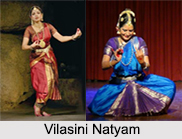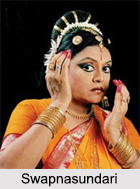 Vilasini Natyam is the true renaissance of the Devadasi dance tradition. It was traditionally performed in temples as a ritual, in courts for the royalties and in the chambers for intellectuals for their aesthetic experience. It was also performed for the general public at dance theatres to educate as well as entertain them through dance.
Vilasini Natyam is the true renaissance of the Devadasi dance tradition. It was traditionally performed in temples as a ritual, in courts for the royalties and in the chambers for intellectuals for their aesthetic experience. It was also performed for the general public at dance theatres to educate as well as entertain them through dance.
The Devadasi Dance tradition, which developed through the temple dances, is important among the dance forms of India. Devadasi dance was the original dance form, from which various other dance forms emerged, especially in the South India, where this Devadasi practice was more prevalent. The classical dances like Bharatnatyam in Tamil Nadu, Kuchipudi in Andhra Pradesh, Odissi in Odisha and Mohiniyattam in Kerala took shape in the tradition of Devadasi dance. These dance forms grew and developed a classical category.
Origin of Vilasini Natyam
Devadasi Dance has been a temple ritual as well as a dance form, although it has been into existence for centuries and perhaps older than many other classical dance forms. As a social ritual it was discredited a long ago and even many laws were brought to abolish the system. Even the dance form went into oblivion, until it was researched and revived by famous Bharatnatyam and Kuchipudi dancer Padma Vibhushan Swapnasundari in last few decades as Vilasini Natyam.
 Devadasi System in India
Devadasi System in India
According to the Indian Puranas, the custom of dedicating maidens to the deity in temples was prevalent in India from very early times. They later came to be known as "Devadasis". In India, the dancing and singing of devadasis was an integral part of temple worship. They were attached to temples in various parts of India, like Kerala, Tamil Nadu, Andhra Pradesh, Mysore, Maharashtra, Rajasthan, Gujarat, West Bengal, Odisha and Jammu and Kashmir. It was a common custom in all places that a maiden underwent a symbolic marriage with the deity before she became a Devadasi. The duties of devadasis included dancing as well as cleaning the temples, providing flowers and other items needed for the conduct of the daily propitiations in the temple, cleaning the rice and the articles of offerings to the deity to help the work of the priests.
At the beginning, the Devadasi institution was confined to worship of Lord Shiva, as times passed other forms of religion also adopted it. By about the 1st century B.C., the system had found a place in Jain, Buddhist and Hindu temples. Later on, the Devadasi system was banned in Independent India.
Preserving and passing on the tradition of Devadasi dance can be truly attributed to the Vilasini Natyam.



















